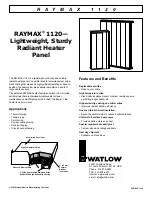
328767-001 www.
americanwaterheater .com 31
Vent Pipe Material
This heater is certi
fi
ed to be installed using Schedule
40 PVC or CPVC or polypropylene or ABS plastic vent
material for the exhaust. The combustion air intake material
may be PVC, ABS, CPVC or polypropylene. Check local
codes to determine which materials are allowed in your
area and only use approved material. All venting material
and components must be joined with the approved primer/
cleaner and solvent cement. Do not cement the venting
system to the heater.
Note:
Use only solid (not foam core) piping. Plastic pipe
and
fi
ttings are available through most plumbing suppliers.
Always check the marking on the pipe to make sure you
are using the correct material.
VENT PIPE PREPARATION
1. INITIAL PREPARATION
•
Make sure the solvent cement you are planning to
use is designed for the speci
fi
c application you are
attempting.
•
Know the physical and chemical characteristics and
limitations of the PVC and CPVC piping materials
that you are about to use.
•
Know the reputation of your manufacturer and their
products.
•
Know your own qualifications or those of your
contractor. The solvent welding technique of joining
PVC and CPVC pipe is a specialized skill just as any
other pipe
fi
tting technique.
•
Closely supervise the installation and inspect the
fi
nished job before start-up.
•
Contact the manufacturer, supplier, or competent
consulting agency if you have any questions about
the application or installation of PVC and CPVC
pipe.
•
Take the time and effort to do a professional job.
Shortcuts will only cause you problems and delays
in start-up. By far, the majority of failures in PVC
and CPVC systems are the result of shortcuts and/
or improper joining techniques.
2. SELECTION OF MATERIALS (PVC and CPVC
VENTING)
•
Cutting Device - Saw or Pipe Cutter
•
Deburring Tool, Knife, File, or Beveling Machine (2”
and above)
•
Brush - Pure Bristle
•
Rag - Cotton (Not Synthetic)
•
Primer and Cleaner
•
Solvent Cement - PVC for PVC Components and
CPVC for CPVC Components only
•
Containers - Metal or Glass to hold Primer and
Cement. Select the type of PVC or CPVC materials
to be used on the basis of their application with
respect to chemical resistance, pressure rating,
temperature characteristics, etc.
•
Insertion Tool - Helpful for larger diameter pipe and
fi
ttings 6” and above.
Read instruction manual before
installing, using or servicing
water heater.
•
Do not store or use gasoline or other flammable vapors and
liquids in the vicinity of this or any other appliance.
•
Avoid all ignition sources if you smell gas.
•
Do not expose water heater control to excessive gas
pressure.
•
Use only gas shown on rating plate.
•
Maintain required clearances to combustibles.
•
Keep ignition sources away from faucets after extended
period of non-use.
Fire or Explosion Hazard
WARNING
Primer:
It is recommended that Tetrahydrofuran (THF) be
used to prepare the surfaces of pipe and
fi
ttings for
solvent welding. Do not use water, rags, gasoline
or any other substitutes for cleaning PVC or CPVC
surfaces. A chemical cleaner such as MEK may be
used.
Cement:
PVC Materials should use ASTM D-2564 Grade
Cement; CPVC Materials should use ASTM F-493
Grade Cement and ABS Materials should use ASTM
D-2235 Grade Cement. Select the proper cement;
Schedule 40 cement should be used for Schedule 40
pipe. Never use all-purpose cements, commercial
glues and adhesives or ABS cement to join PVC or
CPVC pipe and
fi
ttings.
.
•
Primers and cements are
extremely flammable, and must
not be stored or used near heat
or open flame.
•
Also, use only in a well venti-
lated area.
Fire Hazard
WARNING
















































